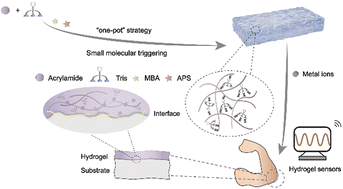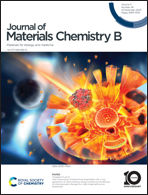A facile strategy to fabricate a skin-like hydrogel with adhesive and highly stretchable attributes through small molecule triggering toward flexible electronics†
Abstract
Polyacrylamide hydrogel is a promising matrix in biomedical applications due to its biocompatibility, transparency and flexibility. However, its implementation in skin-attachable applications is impeded by its inherent deficiency in surface-adaptive adhesion and inadequate mechanical conformity to skin tissues. Herein, tris, a biocompatible small molecule with a triple hydrogen bonding cluster in its molecule structure, is introduced for the first time into a polyacrylamide hydrogel. This incorporation is achieved via a facile one-pot strategy, resulting in a highly stretchable hydrogel with an impressive strain capacity (2574.75 ± 28.19%), a human dermis tissue-compatible Young's modulus (27.89 ± 2.05 kPa) and an intrinsically universal adhesion capacity (16.66 ± 0.32 N). These superior properties are attributed to the elevated hydrogen bonding density and the plasticizing effect induced by tris, without compromising the hydrogel's excellent transparency (>90% transmittance). Moreover, by incorporating calcium ions into the resulting soft adhesive hydrogel, we demonstrate its utility in skin-like sensors, leading to a substantial enhancement in strain sensitivity and electrical conductivity, in conjunction with the plasticizing influence exerted by tris. This work offers a facile and environmentally friendly solution to fabricate ultra-stretchable adhesive polyacrylamide hydrogel matrixes for dynamic surfaces, even under large deformation, which can broaden their potential applications in integrated bioelectronics.

- This article is part of the themed collection: 2023 Journal of Materials Chemistry B HOT Papers


 Please wait while we load your content...
Please wait while we load your content...